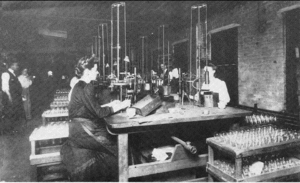Women of Westinghouse
Because so few electrical machines and devices were produced before the late 19th century (except in the field of telegraphy), there was no need for large-scale factory production. However, after the introduction of the incandescent light and the telephone, things began to take off. As in so many other factory situations, as soon as the work was broken down into small, repetitive tasks, factory managers hired women or children to do the work, because they worked for less money than men.
Beginning in 1903, the Westinghouse Company’s factory near Pittsburgh, Pennsylvania, began to make electric motors, a technology that Westinghouse had helped commercialize in the 1890s. The factory had previously been making Westinghouse’s extremely successful brakes for railroad cars. While air brakes had been made by men, when the company began making electric motors in the summer of 1903, it began recruiting women for the jobs. Although in August of 1903 there were still only twelve women working at the plant, the number began to steadily increase.
The young women hired for these jobs were mostly in their 20s or younger and living in the surrounding neighborhoods; some were the daughters of men employed in air brake production. The work of winding what were called the “heavy coils” was hard, requiring the women to handle heavy reels of wire and to tend machines that jerked them back and forth. Some women, however, worked on the “light coils,” which were more easily assembled.
In 1904, Westinghouse invited a motion picture producer called the Biograph Company to film its factory near Pittsburgh. The women coil winders were briefly filmed doing their work, along with many other shots of the other activities in the factory complex. These films survive today in the U.S. Library of Congress. At Westinghouse and elsewhere, women were becoming more and more prominent in the electrical industry, and by 1910 made up about 15% of all electrical workers. Though we know little about the individual coil winders at Westinghouse, the surviving films and descriptions of their working conditions provide a unique snapshot into women’s factory work just after the turn of the 20th century.
